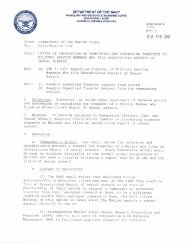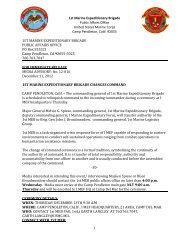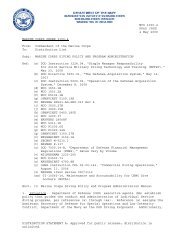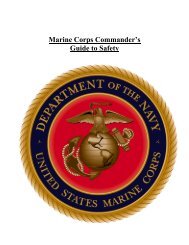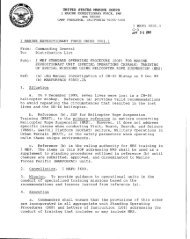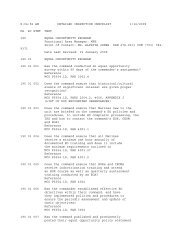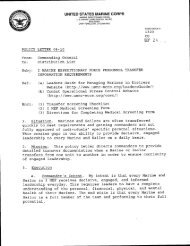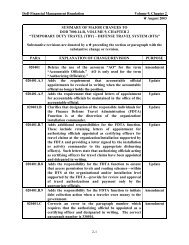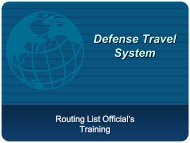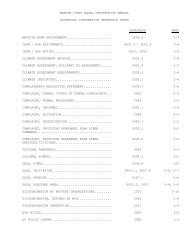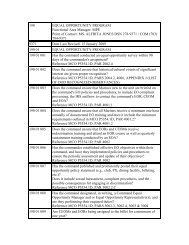personnel qualification standard (pqs) - I Marine Expeditionary ...
personnel qualification standard (pqs) - I Marine Expeditionary ...
personnel qualification standard (pqs) - I Marine Expeditionary ...
You also want an ePaper? Increase the reach of your titles
YUMPU automatically turns print PDFs into web optimized ePapers that Google loves.
110 Force Protection<br />
CIRCUMSTANCES FOR USING DEADLY FORCE.<br />
Deadly force is justified only under conditions of extreme necessity, as a last<br />
resort, when all lesser means have failed or cannot reasonably be employed, and<br />
only under one or more of the following circumstances:<br />
o IN SELF-DEFENSE AND DEFENSE OF OTHERS. When deadly force<br />
reasonably appears necessary to protect security <strong>personnel</strong> or others who<br />
are reasonably believed to be in imminent danger of death or serious<br />
bodily harm.<br />
o IN DEFENSE OF PROPERTY INVOLVING NATIONAL SECURITY<br />
When deadly force reasonably appears to be necessary to prevent the<br />
actual or threatened theft of, damage to, or espionage aimed at property or<br />
information specifically designated by the commanding officer or other<br />
competent authority to be vital to the national security.<br />
o IN DEFENSE OF PROPERTY NOT INVOLVING NATIONAL<br />
SECURITY BUT INHERENTLY DANGEROUS TO OTHERS. When<br />
deadly force reasonably appears to be necessary to prevent the actual theft<br />
or sabotage of property which is inherently dangerous to others; i.e.,<br />
property whose theft or destruction presents a substantial potential danger<br />
of death or serious bodily injury to others, such as operable weapons and<br />
ammunition.<br />
o TO PREVENT OR INTERRUPT SERIOUS OFFENSES AGAINST<br />
PERSONS. When deadly force reasonably appears to be necessary to<br />
prevent the commission of a serious offense involving violence and which<br />
threatens death or serious bodily injury to another (such as murder, arson,<br />
armed robbery, aggravated assault, and rape).<br />
o APPREHENSION OR ARREST. When deadly force reasonably appears<br />
to be necessary to apprehend or prevent the escape of a person when<br />
probable cause exists to believe that a person has committed an offense of<br />
the nature specified within the circumstances outlined above.<br />
o ESCAPES. When deadly force reasonably appears necessary to prevent<br />
the escape of a prisoner, provided security/LE <strong>personnel</strong> have probable<br />
cause to believe that the escaping prisoner poses a threat of serious bodily<br />
harm to security/LE <strong>personnel</strong> or others.<br />
o LAWFUL ORDER. The use of deadly force is authorized when directed<br />
by the lawful order of any competent authority and when the order meets<br />
the criteria of one of the circumstances above. Specifically, the person<br />
who is directed to use deadly force must have a clear description of the<br />
person against whom it is authorized, and at least a general knowledge of<br />
the circumstances that warrant deadly force.<br />
110.4 Discuss the use of less than lethal force.<br />
Security <strong>personnel</strong> are often armed with weapons or equipment other than firearms. Even<br />
though their intended purpose is non-lethal, when applied, they could cause death or<br />
serious bodily harm.<br />
110-8



